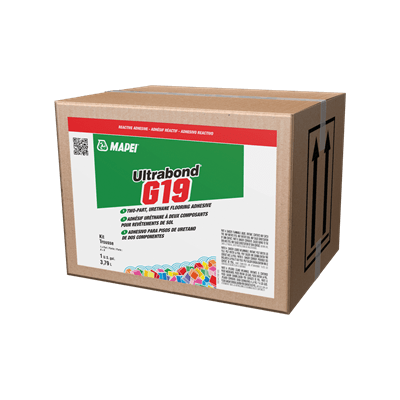Choosing the right adhesive for resilient flooring can feel overwhelming, but there’s a simple process I follow before making a recommendation. Here’s how you can apply it to your own projects. Hopefully, it will help some of you to better understand what kinds of adhesives to use, for what flooring and in what environment.
One other thing I like to do before recommending a MAPEI adhesive is to read the data sheets and installation instructions from the flooring manufacturer. These documents can give us further information about what types of adhesives they approve for use with their products. For example, are the approved adhesives all SBRs (styrene-butadiene rubber), Acrylics or Reactives? Are all the recommended adhesives “wet-set”, “semi-wet” or “pressure-sensitive”? Are there any limitations on the type of adhesive to use?
Let’s walk through a real-world example to see how these factors come into play. Say we need to install rubber sheet flooring in an in-patient suite in a hospital with a concrete substrate. We now know what kind of flooring we’re installing, where we are installing it, the environment and traffic the flooring could be exposed to, and finally, the substrate it will be bonded directly to. When we look up the flooring’s data sheets, we see that the adhesives they recommend are a pretty wide range of acrylic-based, “wet-set” or “pressure-sensitive” adhesives with a few reactive adhesives.
We know the environment will be a normal indoor environment, temperature will be a steady 20 to 22 degrees C and relative humidity will be between 30% and 60%. Also, it’s not a “wet” area or a challenging substrate to bond to like metal, so we can rule out the need for an epoxy or for urethanes like Ultrabond® G19 or Ultrabond G21.
Since this is a hospital we should expect heavier rolling loads from things like hospital beds and other equipment, and while pressure-sensitive adhesives like Ultrabond ECO® 373 have come a long way, they still aren’t the best at preventing indentation of flooring due to heavy rolling loads, so we probably should look to using a harder-setting wet-set adhesive instead.
What MAPEI adhesive should we use then? We’re installing interior rubber sheet flooring atop a porous concrete floor that will be exposed to rolling loads. We’re looking for a hard-setting, acrylic-based adhesive and by process of elimination, Ultrabond ECO 307 looks perfect! It’s got all the attributes we need, including resistance to heavy rolling loads and to high moisture – all the while providing excellent bond strength, shear strength and gap control.
Hopefully this process makes your next adhesive selection easier. And remember—when in doubt, MAPEI’s Technical Services team is only a phone call or email away.






Toll-free within Canada:
Technical Services at 1-800-361-9309
Customer Service at 1-800-668-1212
Copyright © 2025 MAPEI Inc. All rights reserved.
2900, avenue Francis-Hughes, Laval (Québec) H7L 3J5
Comments
Load more comments